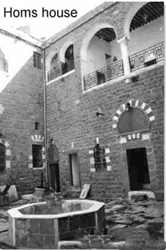The incomparable diversity of both old and modern building styles in the old city of Homs, has created a harmonious panel representing the architectural design splendor on one hand, and showing -through its narrow streets and contiguous houses- the pleasant memories of the good times on the other.
Homs is located on a volcanic land still dwelling a large number of old houses, that were turned into traditional museums of Islamic handicrafts and miniatures, or as restaurants crowded with heritage and authenticity fans.
Among the most famous Homsi residences which still retain originality until today are: Abdullah Farkouh residence in Boustan el-Diwan Road, as well as the 270 year old domicile of al-Akhras in the Raouche district which has been converted into a restaurant, in addition to al-Aga House, Julia Domina Café, the house of Moufeed al-Ameen and Beit Al-Zahrawi which was turned to a Folkloric Museum.
Structurally speaking , the old city of Homs takes, a square-like shape. Its four of its seven gates are located on the city’s four corners. They are: Palmyra Gate, Aldreb Gate, the Lions Gate, Hood Gate, the Turkmen Gate , “al-Masdoud” (blocked) Gate, and the Market Gate.
There is only one straight road in the old city of Homs, since all the city’s roads take a zigzag shape either for security or climatic reasons, to eliminate the dangers caused by the strong westerly winds that strikes the city.
An old Homsi house has most Arabic architecture elements, the difference is only in some particulars resulting from cultural or economic situation. The old Homsi house is Surrounded with external wall, consisting of an entrance leading to the interior courtyard and a number of rooms which are separated by what is called “al-Lioan” which was the family setting room. In the courtyard there are basins planted with fruitful trees such as loquat, figs, berries, pomegranate, apricot; besides charming yellow and white jasmine , damask rose and mint; in addition to the famous Homsi grapevine. The home garden, in many cases, is really considered the family drugstore.
Researcher Faisal Shikhani, says ” Homs building was called “Al-abgayh”, this nomination dates back to 1500 AD, signifying piebald, since the city’s households were built by black and white stones forming a wonderful natural chess board”.
He clarified that Homs architectural structure dates back to the Roman era during the rule of Sun Grams family; pointing out that during Islamic conquest mosques and palaces constructions have profited from Homsi people experience in using black stones, supplemented by bricks since that was easier and less expensive.
Islamic structure was influenced by Christian churches, Mamluk and Ottoman architectural styles. Accordingly, one can see several models of buildings in one mosque, for example, Khalid bin al-Walid mosque, was built according to the Ottoman style, while its minarets were of the Mamluki style, built from the famous Homsi black stones.
Amal Farhat


 Home
Home